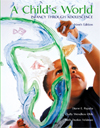 |  A Child's World: Infancy through Adolescence, 9/e Diane E. Papalia,
University of Wisconsin-Madison
Sally Wendkos Olds
Ruth Duskin Feldman
Cognitive Development in Middle Childhood
Chapter Outline
Section I Piagetian Approach: The Concrete Operational Child
Cognitive AdvancesSpaceCausalityCategorizationConservationNumber an Mathematics
Influences of Neurological Development and Culture
Moral Reasoning |
 |  |  | Section II Information-Processing Approach: Memory and Other Processing Skills
Basic Processes and Capacities
Metamemory: Understanding Memory
Mnemonics: Strategies for Remembering
Selective Attention
Information Processing and Piagetian Tasks |
 |  |  | Section III Psychometric Approach: Assessment of Intelligence
Traditional Group and Individual Tests
The IQ ControversyInfluence of SchoolingInfluence of EthnicityCultural Bias
Is There More Than One Intelligence?Gardner's Theory of Multiple IntelligencesSternberg's Triarchic Theory of Intelligence
Alternative Directions in Intelligence Testing |
 |  |  | Section IV Language and Literacy
Vocabulary, Grammar, and Syntax
Pragmatics: Knowledge about Communication
LiteracyReadingWriting |
 |  |  | Section V The Child in School
Entering First Grade
Environmental Influences on School AchievementThe FamilyTeacher ExpectationThe Educational SystemThe Culture
Second Language Education
Children with Learning ProblemsMental RetardationLearning disabilitiesHyperactivity and Attention DeficitsEducating Children with Disabilities
Gifted ChildrenIdentifying Gifted ChildrenThe Lives of Gifted ChildrenDefining and Measuring CreativityEducating Gifted, Creative, and Talented Children |
|



 2002 McGraw-Hill Higher Education
2002 McGraw-Hill Higher Education